In the Cycling magazine, 11th January 1929 the following announcement appeared “With the object of resuscitating the Addiscombe C C, founded in 1906 and now for many years defunct, a meeting has been called for January 15th at the Dorcas Rooms, Clyde Hall, Addiscombe, Croydon. Mr C. F. Davey will take the chair.”
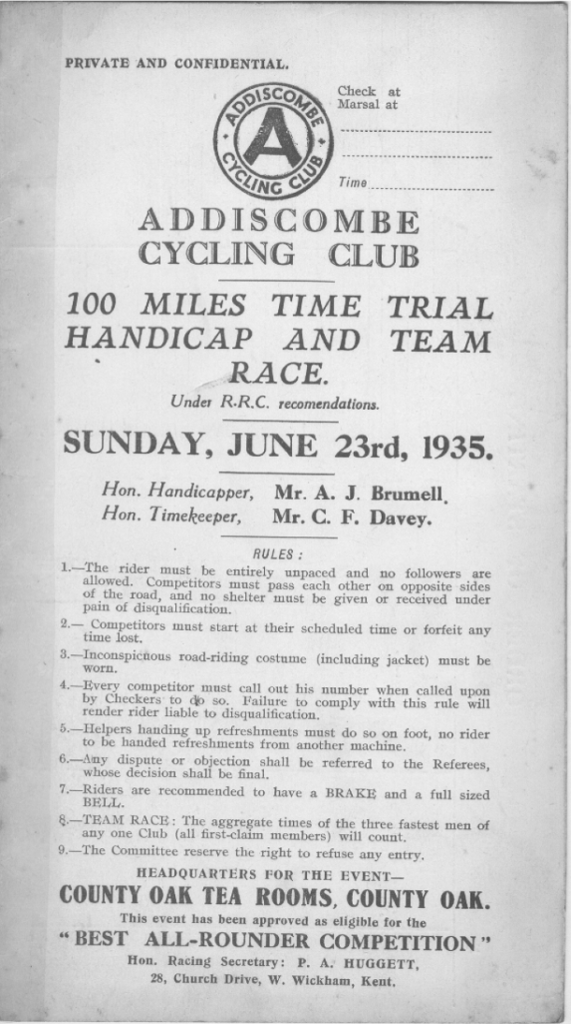
And so it happened, the inaugural meeting of the current Addiscombe Cycling Club was held on 15th January 1929 with members of the Vegetarian C & A C, Norwood Paragon, Cyclists’ Touring Club and others who had no previous club allegiance. Such was the enthusiasm everything moved very quickly forward with the election of officers. Charles F. Davey was elected as both President and Chairman, positions he was to hold for the next twenty-one years, with Stanley A. Roach, taking the position of Hon. Secretary.
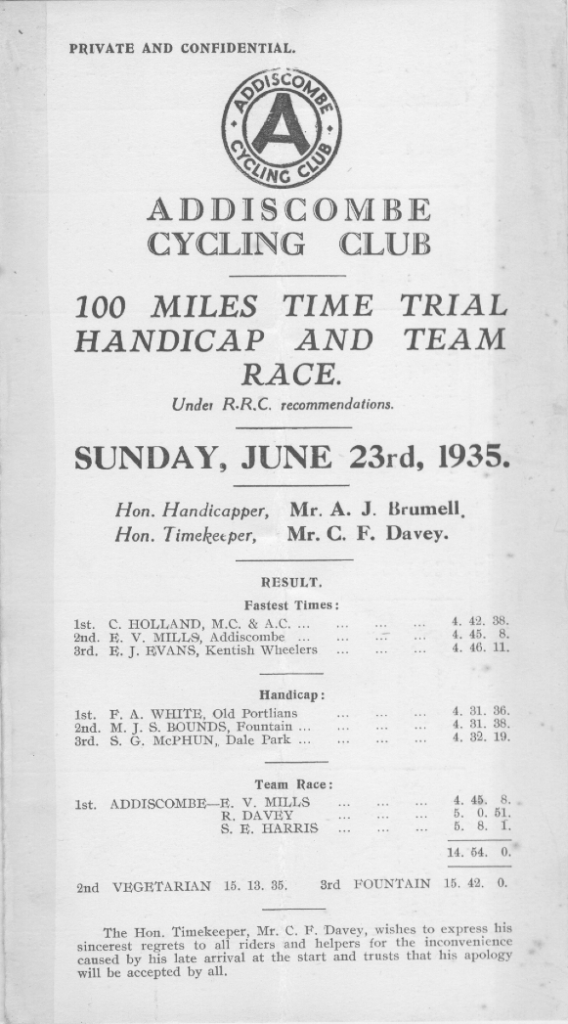
Founder members recorded in the Minutes of 15th January 1929 meeting
S. E. Armstrong, H. Bellingham, R. P. Bott, A. J. Brumell, A. W. Brumell, C. F. Davey, S. England, P. N. Heathfield, A. Hodgson, S. J. Hook, P. A. Huggett, W. Norris, Mr Pearce, R. Penton, S. A. Roach, Mr Sackett, E. Simpson, H. E. E. Smith, W. E. Wells and C. Willcox.
Further meetings were promptly held to frame rules and regulations that were formally adopted at an Annual General Meeting held on 29th January 1929. On 25th January 1929 Charlie Davey had donated two trophies, the 25 Cup, originally won outright by him following wins in 1906/7/8, and the 50 Cup, and such was his contact with the Trade that shortly after the Palmer Tyre Company donated a trophy for a Club Championship to be competed for over 25, 50 and 100 miles. By 19th February 1929 it was agreed to affiliate the club to the Southern Counties Cycling Union and the Southern Road Records Association, two associations the club still continues to support.
From 1922 clubs promoting Open time trials could affiliate to the Road Racing Council (RRC) with its loosely framed rules and eight members made their first event the Kentish Wheelers Novices 25 on 17th March 1929. Rider No 2 on the card was S. E. Armstrong, who was to remain a member for the rest of his long life. Our fastest entrant was J. C. “Jack” Hall with 1.13.28, 4th fastest. Club events were the responsibility of the clubs themselves. The course used for the first club 25 is not recorded but for a 50 it was agreed “to use the present 25 course and to add a section of the Horsham/Guildford road and the secretary was instructed to measure same”. Club event courses were frequently changed or recognised Open event routes adapted to suit members. Accuracy of distance cannot be guaranteed as these courses were often measured on maps!
The Club affiliated to the National Cyclists’ Union in 1930.

Socials formed an active part of club life, the first one being held at Clyde Hall, Addiscombe, as early as 26th February 1930. Entertainers were engaged and refreshments provided during the interval. By the early 1930’s the Socials were referred to as “Dances” and as many as eight a year were being held, members frequently being berated for their lack of attendance.
The first Club Dinner was held at the Café Royal, North End, Croydon, on Thursday evening, 16th January 1930 and would continue to be held at this venue until 1939. H. W. Bartleet, President of the Belle Vue C. C. proposed the toast to the Club and provided “humorous entertainment”. In addition, there was a rendition from our own President, Charles F. Davey, an accomplished tenor who was accompanied by soprano, Miss Kay Killick. The Addiscombe 25 cup was won by “Pip” Heathfield. (Pip is remembered annually by a competition for the fastest club rider in a selected Addiscombe promotion.) The 50 trophy was won by Percy Huggett and the trophy presented by the Palmer Tyre Company went to Stan Roach, club champion over 25, 50 and 100 miles.

Two hundred and thirty-nine riders wished to compete in the Southend Wheelers 25 of October 1932. Fifty-seven forms were returned because riders were members of clubs affiliated to the Road Racing Council and the Southend Wheelers 25 was a non-RRC event. One hundred and eighty-two competitors were accepted, forty competitors did not start because it rained and eighteen did not finish for many reasons, mainly because it rained, in fact it poured throughout the entire event. Bill Paul ran out the winner in 1.04.15, Ernie Mills was seventh and with Percy Huggett the Addiscombe took the team award.

And what of these racing men who formed this great club?
Stanley Roach was the first Hon. General Secretary of the Club, a position he held until 1936 and then again from 1974 to 1979. In addition he edited and produced The Gazette from 1949 to 1952.

He won the first Club 50 promoted in May 1929 and placed third fastest in the Club 100 in the August. That a newly formed club could promote club events from 25 to 100 miles shows great enthusiasm on the part of its membership.
Tandem racing was extremely popular prior up to World War 2 and Roach paired up with Harry Jelfs of the Wren Wheelers.
Percy A. Huggett was a formidable rider who went on to become an extremely efficient official. Originally elected Vice-Captain, within a year he became Captain, then racing secretary and general secretary, before settling down as treasurer, a job he fulfilled for over 30 years.
His duties to the sport extended beyond club level and he acted as an official timekeeper spending very many hours officiating at time trials and on record attempts, as well as being secretary/treasurer of the Southern Road Records Association and treasurer of the London South District of the Road Time Trials Council during his lifetime.
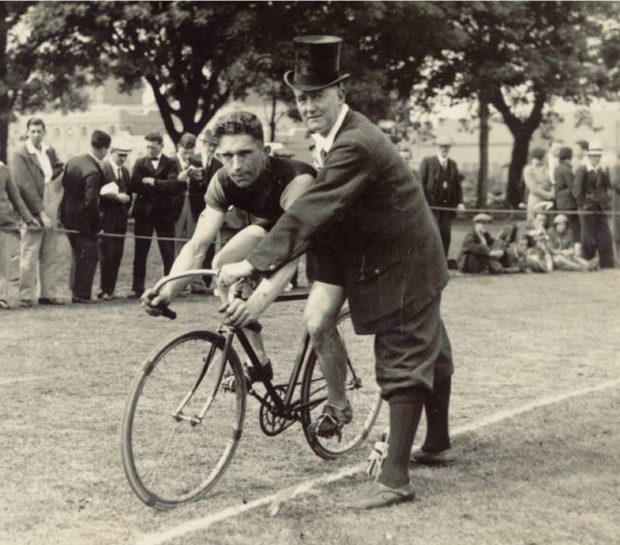
Many committee meetings took place at his home and such was his wife Molly’s expertise at cake making that good attendances were always assured.
William G. “Bill” Paul quickly established his credentials as a fast solo time trial rider winning his first open event in 1929 and his last in 1943. At a time when tandem racing was extremely popular and attracted fields of up to 100, he and Percy Huggett paired up and scored numerous tandem successes both on the track and in time trials. In 1930 they were considered to be the fastest tandem pair in the country and their 30 miles win of 1.06.40 was a National Competition tandem record that stood for four years.
Ernest Victor Mills joined the club as a raw novice in 1931 and quickly found winning form, living up to his second name. With three solo wins in the Birchfield 50 he made the trophy his own as well as winning close on forty open time trials before announcing his first retirement in 1946. In 1933 he and Bill Wells won the Epsom tandem 30 beating Huggett and Paul into second place by over 2 minutes. The Addiscombe, with seven tandem pairs in a field of forty-six, took both first and second team awards.
By 1935 Ernie Mills had broken all the club’s bicycle records from 25 miles to 12 hours. Amongst his many other successes Mills won the National Tandem-Paced Championship in 1936 and 37 and was selected to ride in the 1936 Olympic Games in Berlin as a member of the 4,000 metres Pursuit Team that finished third behind the French and Italians. However, it was as a tandem pair that Ernie Mills and Bill Paul were to become household names starting their partnership in 1934 at a time when Percy Huggett was turning his attention more to administration and married life. They broke the British One Hour Unpaced Tandem record at Herne Hill that year covering 28 miles 653 yards and again in 1936 with 30 miles 793 yards. In time trials, five National Tandem Competition records fell to them over three years: 30 miles in the Epsom C.C.’s promotions of 1936 (1.05.03) and 1937 (1.03.14), 50 miles in the Marlborough A.C.’s events of 1937 (1.49.00) and 1939 (1.48.16) and in the Oak C.C. tandem 100 of 1938 3.53.12. Their attempt on the Road Records Association (RRA) Brighton & Back failed but they successfully broke the Southern Road Records Association (SRRA) 50- and 100-miles records.
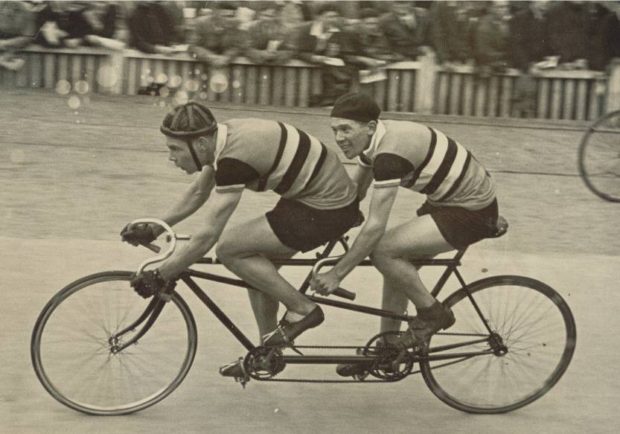
In 1937 Cycling magazine opened up a public subscription to send Mills to Milan to attack the World Hour record currently standing to Maurice Richard at 28 miles 368 yards. Reference was also made in the appeal to the British tandem hour record that had fallen to Mills and Paul in 1936. Donations poured in ranging from £5 from the Dunlop Tyre Company down to 6d from many club folk. After two weeks the fund stood at £140 and the trip was confirmed. With the appeal having been judged so successful it was ultimately agreed to send Harry Hill, Sheffield Phoenix C.C. to attack the World Hour Bicycle record, and Mills and Paul the World Tandem records.
The trio, accompanied by manager Frank Slemen and Alex Josey of “Cycling”, departed for Milan in October 1937 by the fastest route – train and boat – after having ridden the Comet 25 earlier that same morning. Twenty-four hours later they arrived in Milan having spent the night trying to sleep sitting upright in the railway carriage. Bill Paul later reported that compared to Herne Hill track the famous Vigorelli track in Milan was like riding the wall of death and it took a little getting used to before they could make any record attempt. Quoting from an article he later wrote for the club magazine:
“It was decided that we would make Sunday the big day and go for everything up to one hour and the 50 kilometres. Some of the officials would have preferred another day because on Sunday there was an important football game at the Stadium that they did not wish to miss, but as our time was very limited, we had to insist.

We started our attempt at 2.30 pm. Frank had prepared a schedule and arranged for the lap bell to be struck and that a person would move to a certain spot if we were beating the record on that lap. From the word go it was tough. For a start we had a gear of 116 and the rules did not allow the slightest push off and to get going from a dead start with a gear that size was hard. It was not long before we got into our stride and round the bankings Ernie was just missing the sandbags, following the yellow line as closely as he could. We soon got inside our schedule and were riding a lot better with the gear of 116 than we had previously with the gear of 105, which had been too low. We were inside our schedule on every lap except one about halfway through, when we drifted back a couple of seconds. The next lap we were back beating the record again, and we carried on for the hour and were only 1 second over the hour for the 50 km. We were over the moon when we had finished, not only because we had beaten the records but also because we had justified the support of all the people who had subscribed to the fund and made the trip possible.”
Mills and Paul’s spectacular ride resulted in ten World Tandem Records from 1 km to 50 km, plus 49 km 991m for the coveted “Hour”, an improvement of 955 metres over the previous record. They also set twelve new records from 1 to 30 miles and 31 miles 113 yards for the Hour. Harry Hill returned home with three bicycle World records plus the best solo amateur performance at the Hour. “Cycling” devoted four pages to the success story in their issue of 20th October 1937 and a further five pages the following week.
Note: Following World War 2 the governing body, the UCI, decided to remove all tandem records from their books but the Mills and Paul Hour record remained an attractive challenge and despite several attempts it was 63 years before the record was finally beaten in 2000 at the new Manchester Velodrome by a pair from the Rutland C.C. Bill, by then an octogenarian, was among the first to send his congratulations. He died in 2003 aged 92. Ernie had died in October 1972 following a long illness. The pair were immortalised in John Player’s set of Cycling cigarette cards, No 45, and their early achievements are recorded in the Golden Book of Cycling, established by ‘Cycling’ and now maintained by the Pedal Club.
In December 1937 Ernie Mills was invited to ride in the Empire Games in Australia where he finished third in the 1,000 metres time trial and was 4th in the 100 km Massed Start Race with only inches separating the first four across the line. While in the country Mills broke the Australian track records for the 1-mile standing start and the Hour, then on his way home rode at meetings in India gaining a second place in one event. Meanwhile, back at home, Bill Paul was still very active and in 1938 bettered the National Competition bicycle record in the Alton 30 miles TT.
Mills and Paul rounded off the pre-war years with numerous solo wins in classic events, at least seven tandem wins in time trials in 1938, a further four in 1939 and the Southern RRA tandem 100 record. Mills finished a very creditable third in the National Best All-Rounder competition of 1938.
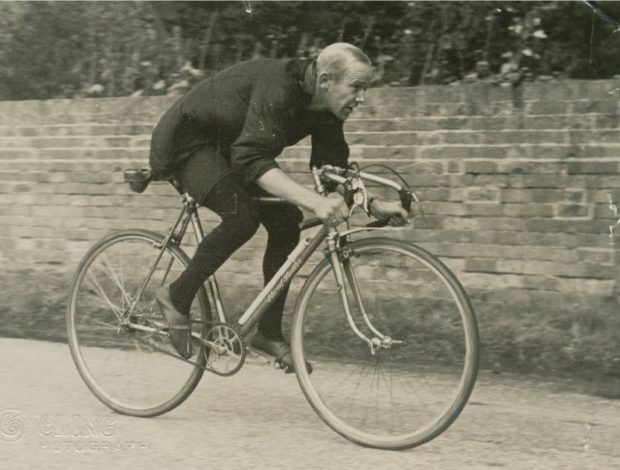
Many photos of both Mills and Paul appeared in Cycling and The Bicycle weekly magazines but are unsuitable for copying. A browse through the scrapbooks for the period 1929-39 shows other very capable riders. Ron Davey (Charlie’s nephew) was quite a handy rider taking the club championship in 1931 before Stan Harvey dominated the title for the next three years and won the Palmer trophy outright but more of Harvey later, his best years were yet to come.
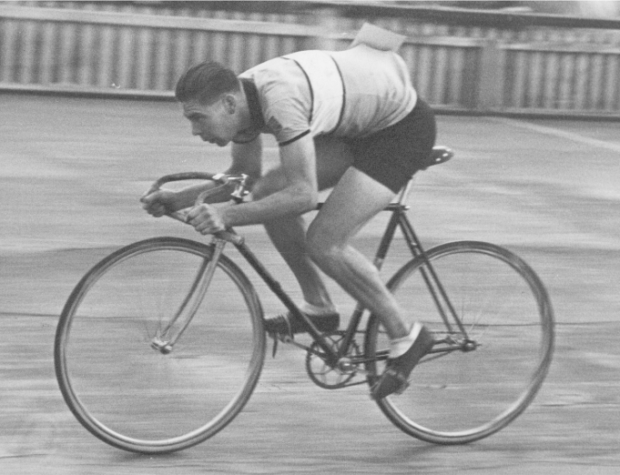
Ex-pro Charlie Davey, at the age of 47, in 1934 made an unsuccessful attempt on the RRA and SRRA 24 hours records, blustery weather causing his retirement after 130 miles. Charlie E. Cooper and R. W. “Bob” Rose were another successful tandem pair winning the Old Portlians and Southern Roads Tandem 50’s and Oak Tandem 100 in 1936. Riding bicycles, they also placed first and second in the Wisbech Wheelers 50 later in the year. Arthur Kinnaird, Len Muller, Eric Purvis, Stan Hook, Jack Hall, and Stan Harris all left their mark.
With so many active members it followed that the club decided to promote an Open time trial and 100 miles was the chosen distance with the first event on 23rd June 1935. With a start at Pound Hill on the eastern edge of Crawley the route went north to Woodhatch, across to Smallfield and out round Edenbridge and Leigh Green before returning to finish in Old Hollow, west of Copthorne. The event, promoted by Percy Huggett, attracted 69 entrants with Charlie Holland, Midland C. & A.C. the fastest rider in 4.42.38, Ernie Mills second and Addiscombe taking the team award. The Open 100-time tria1 was repeated in 1936, with the fastest rider E. J. Evans, Kentish Wheelers, 4.52.27 and in 1937 Stan Butler, Norwood Paragon, took the honours in 4.40.02. In 1938 member W. A. “Bill” Hobbs pulled off a surprise win by over three minutes finishing in 4.48.52 and taking second handicap for the second consecutive year. By 1939 it was decided to discontinue the event as despite a call for a southern 100 it was recorded that “it had failed to attract a classic field”. Bill Hobbs, now a very promising rider, also won the Catford 50 that year.
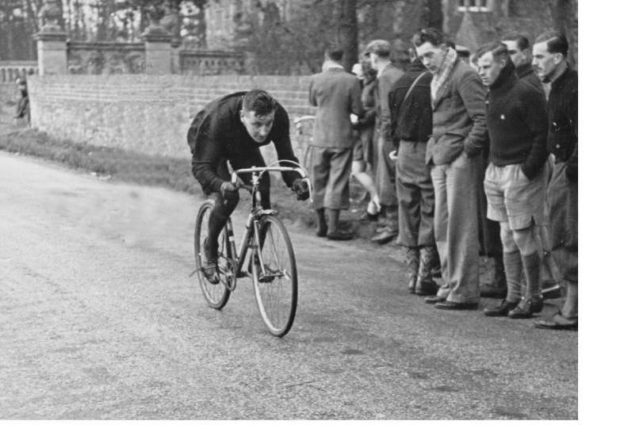
In the immediate pre-war years another member riding high was A. A. ‘Bob’ Smith. Amongst Smith’s successes were a win in the 13th Wheelers 25 of 1937, with a repeat win the following year of 1.03.35 and course record. In 1938 he also won the West London 50 in 2.16.36, with Ernie Mills 2nd in 2.17.16, followed a week later by the Catford 50 in 2.12.22.
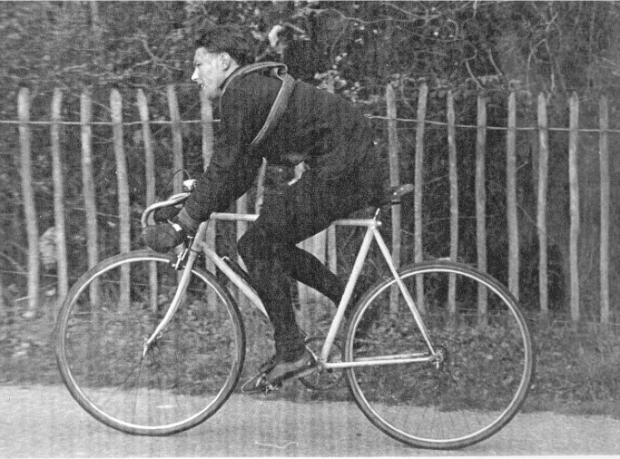
In the first decade of the club time trials had proved the main attraction to members (and this is still evident by the number of time trial trophies annually up for competition). Record breaking too had been encouraged by Charlie Davey with his background in professional record breaking both as a rider and later, manager. Track racing, both on grass and on hard track, and massed start racing on closed circuits, locally Brooklands track, were also attracting a few members. In 1939 Ernie Mills, A.A. “Bob” Smith, Bill and Len Hobbs rode the Isle of Man massed start. Mills finished in 15th position with Len Hobbs 31st but Smith was unfortunate to crash in a big pile-up at the Ramsey prime and Bill Hobbs had his back wheel collapse as he was coming down the mountain. The club hired a cabin for its own usage under the side stands at Herne Hill in 1939. The same year the club joined the newly formed local section of the Bicycle Polo League and Phil Lewis got a team together but the Addiscombe never really took this branch of the sport to heart and finally discontinued their membership in 1950.
Occasional items in the Minutes remind one how times and attitudes change. At the 1934 AGM, Ted Davey moved a motion “That any member competing in road time trials or races must not undress or dress by the roadside but must retire to some part or place in absolute seclusion.” The motion received a seconder and was then referred back to committee. “The complaint”, as the committee viewed it, appears to have been “left on the table” and Ted Davey resigned his membership at the following meeting.
Like many of the early cycling club’s membership was restricted to the male sex, or Robin Kingsland gentlemen as the rulebook defined them. Quite a few members drew in their brothers and in some cases, fathers too. Ernie Mills and twin brother Wilf; Harry, Bill and Ron Crumbley; Bill, Maurice and Bernard Wells; Ken and Norman Cox; Bill, Len and Harold Hobbs; Harold, Edgar and Jack Checkley; Bill and John Watts, all became members, and there was the Armstrong family. Sid Armstrong took the club championship in 1936, 1946 and 1947 and Fred Armstrong in 1937. It was 1935 before the rules opened membership to males under 18. Bob Halfacre appears to be the first to have taken advantage of this change.
In addition to the promotion of social evenings and dances, club runs as early as 1929 had included a Wednesday evening ride departing Addiscombe station 7.30 p.m. Sunday runs were well supported and the format of all-day rides with stops for elevenses, lunch and tea continued into the 1960’s. The venues were known well in advance and members could join in as suited their racing programme or family commitments. On one reported “Christmas Mystery Run” of the fifteen that set out only three reached Godstone without mishap. One tricky hill had accounted for two broken lamps, four mudguards, two punctures and just for luck Percy Huggett pulled half of his bars clean off. This was presumably one of the autumn rough-stuff rides (off-road) that Huggett was known to arrange for the hardy types.

E J ‘Jack’ Finch (pictured) was one of many who rode time trials regularly. Competing against their peers and own personal times, the great draw of time trialling is that one does not have to be a champion to enjoy the sport. Other time trial enthusiasts of this era were Henry Cady, Ian Bucknole, Len Martin, Stan Hardacre, Gordon Emberson, Bert Nash and Walter Polatch.

Among the membership were Steve and Phil Lewis. Phil, riding as a private member of Kent C A, had in 1936 been the holder of the Competition Record for the 200 miles time trial, a recognised distance that was to disappear after the 1930’s. Brother Steve was a fine artist as well as a cyclist and his “Bim” cartoons appeared regularly in “Cycling” until his untimely death in 1941.
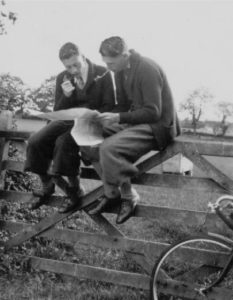
From 1929 to 1934 the club, along with many others, published a brief summary of their achievements in the Southern Cyclist, the monthly journal of the Southern Counties C U. In January 1935 it was agreed a free monthly Gazette would be issued in duplicated form to all members “dealing in a comprehensive manner with club activities”. Notes appearing in the Southern Cyclist would be discontinued. The earliest known copies of The Addiscombe Gazette still in existence date from July 1937 – issue No 30. Tom Smith’s Café at Crawley was first established as the club’s “country HQ”, a good place for meals or overnight accommodation for the many time trials held in the area. Bill Paul’s mother set up the County Oak café (now lost to a modern retail park) and this became a regular haunt with as many as thirty-six recorded sitting down to tea in 1933. Clubroom activities included darts, table tennis, billiards with Bill Wells left to organise tournaments. “Indoor pursuit racing” also gets a mention and must have caused mayhem and at one clubroom members were censured for playing the piano after 10 pm. Perhaps that is why they tended to move clubrooms occasionally!
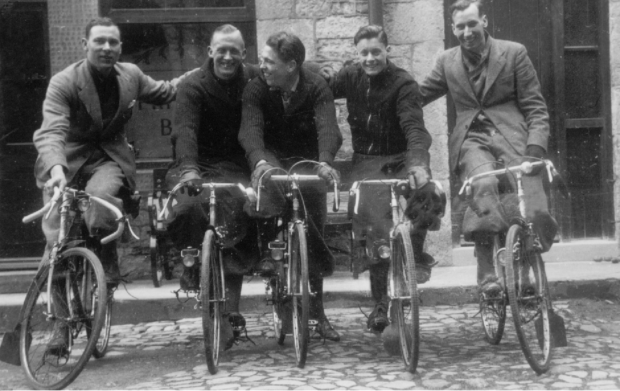
From the club’s commencement members were touring further afield than the home counties – a weekend run to Lulworth Cove by two tandem pairs, two members toured Germany, three visited Paris for the World Championships, plus Easter and Whit weekend tours to the New Forest. Dorset and the Cotswolds were other popular venues for years and Christmas 1937 saw members visit the Isle of Wight.
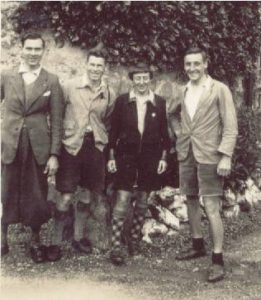
It is not surprising that wives, sisters and girl friends should want to become members of the club. They provided support, rode on club runs and were presumably useful as partners at the dances!
In 1939 Associate membership was introduced for lady members though the voting in favour was not unanimous. The clubroom was to be open to them on the first Tuesday of every month and this would be deemed Ladies’ Night. They were also to be permitted to purchase a club ‘dress badge’ and take-out affiliation to the National Cyclists Union via the Addiscombe. The first four Associate members accepted were Vi Armstrong (sister to Sid & Fred), and wives Eva Davey, Mabel Heathfield and Molly Huggett with others quickly following. Then came World War 2 and lifestyles changed for everyone.
- An Introduction to our History
- The 1883 Addiscombe Cycling Club
- The 1906 Addiscombe Cycling Club
- An Historical Background to the Road Record Associations
- A Brief Historical Background to Cycling Time Trials
- The Club’s Revival, 1929 to 1939
- The Club in Wartime, 1940 to 1946
- The Post-War Years, 1947 to 1957
- Post-War Track and Roller Racing
- The Men in Post-War Time Trials
- The Women in Post-War Time Trials
- Post-War Closed Circuit and Road Racing
- An Influx of New Riders and the Passing of a Statesman, 1958 to 1964
- The Club Heads Towards its Golden Jubilee, 1965 to 1978
- Membership Declines, 1979 to 1987
- The Arrival of the Young Mountain Bikers, 1988 to 1994
- Another Period of Declining Membership, 1995 to 1999
- New Century and a New Look for the Addiscombe, 2000 to 2006




